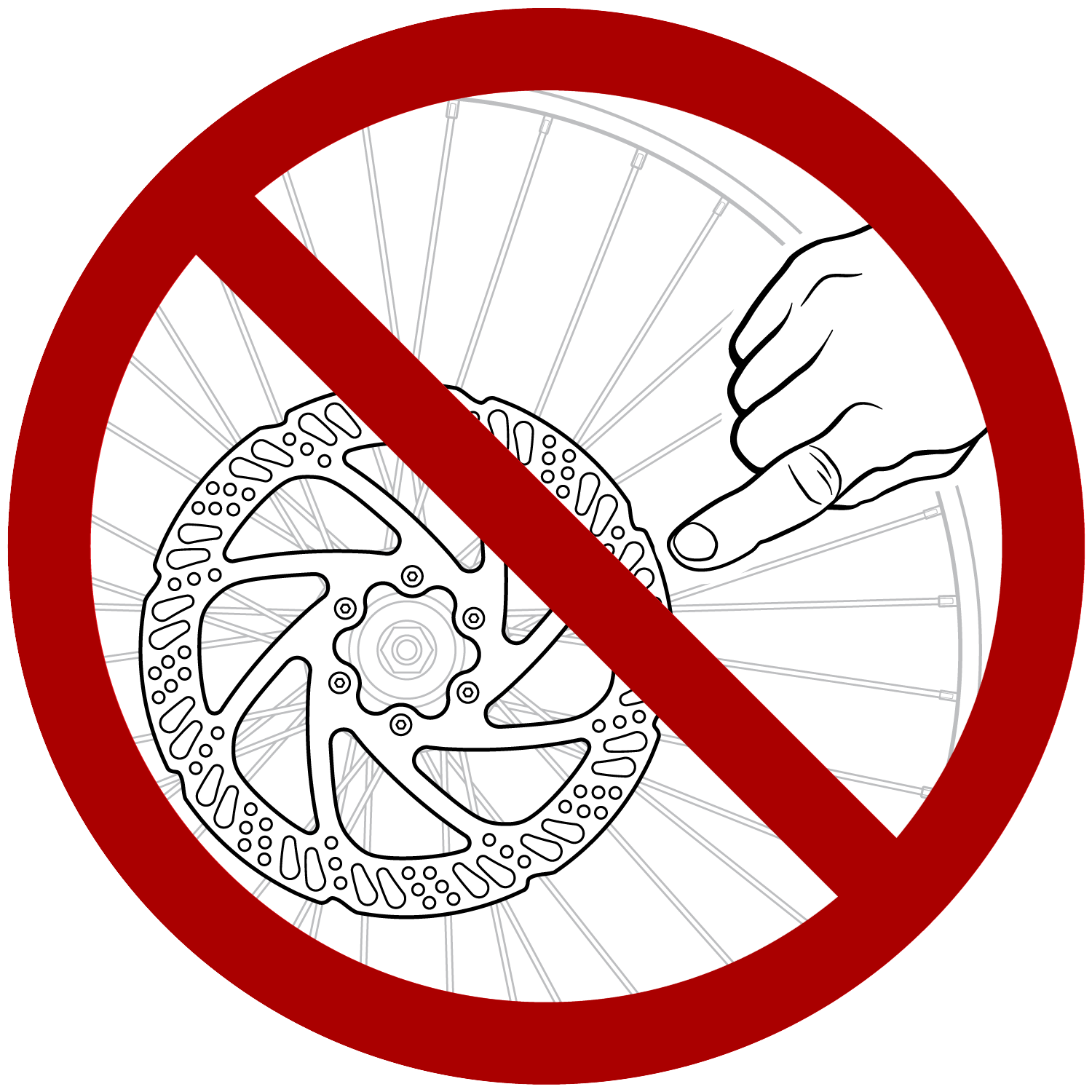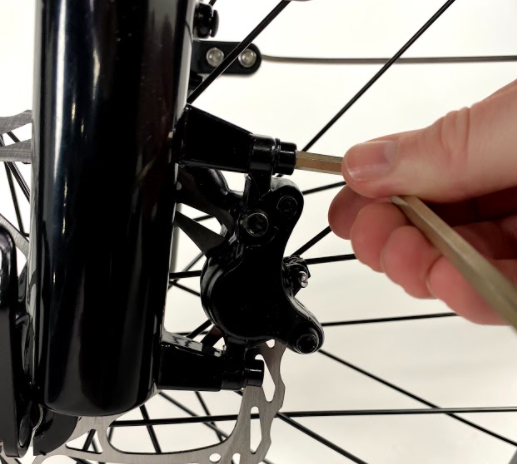Hydraulic brakes adjustment guide
With a brand new bike, a small amount of brake rubbing and noise can occur during a break-in period known as bedding-in new brakes. If your brakes are new, click HERE to complete the bedding-in brakes process. Rubbing and noise will often resolve over time with normal brake use (after about 25-50 miles). Ebike brakes and components may wear out faster than would be the case for non-motorized bicycles, requiring more service. If you are experiencing brake noise after the break-in period (25-50 miles), follow the steps in this article to adjust the brakes.
The hydraulic brake adjustment will involve:
- Checking the wheel to make sure it is fully seated in the frame dropouts. An improperly seated wheel can cause the brake rotor on the wheel to rub on the brake pads and cause noise.
- Checking that the brake rotor is true (straight) and in good condition. A damaged or dirty brake rotor can lead to reduced brake performance or noise.
- Centering the brake caliper by adjusting the positioning so the brake pads are centered and parallel to the brake rotor. A brake pad or brake caliper that is not properly positioned can lead to reduced brake performance or noise.
- Adjusting the brake lever reach. Make sure the brake lever is adjusted to a position that is comfortable for you.
These instructions only apply to ebike models with hydraulic brakes (RadCity 5, RadRover 6, RadRunner 3 Plus, RadExpand 5 Plus, RadWagon 5, Radster Road, Radster Trail, RadKick Belt Drive and RadKick 7-Speed). To adjust ebikes with mechanical brakes, refer to this article.
Do not flip over your ebike to perform work on hydraulic brakes, as this can introduce air bubbles into the brake lines, which can lead to brake failure. Any work on hydraulic brakes must be performed while the ebike is on a bike repair stand or lift. If you do not have the required tools or are not confident in your ability to successfully and safely perform all steps, we strongly recommend having the work performed or checked by a local, certified, and reputable bike mechanic.
Tools Needed:
- Bike repair stand or lift
- 2 mm and 5 mm Allen wrenches
- Torque wrench
- 18 mm wrench
- Flat side cutters
- A sheet of paper
The hardware or tool needed for your model may be slightly different. Make sure you use the correct tool and size for your bolts. Always make sure the tool is pressed firmly into the bolt head and turned slowly to prevent damaging the bolt.
- Get the bike ready for maintenance. Turn off the bike, remove the battery, and press and hold the Power button to discharge any remaining power.
- Identify which brake needs to be adjusted. Keep in mind that the left brake lever controls the front brake, and the right brake lever controls the rear brake.
- Check that the wheel is fully seated in the dropouts, centered with the bike, and that the quick release lever is properly tensioned. A loose wheel, or one that is not centered in the fork dropouts, can cause brake noise when the brake rotor rubs on the brake pads as the wheel spins. If the wheel is not fully seated in the dropouts or centered with the bike, follow the steps below to adjust the wheel.

- To adjust the front wheel:
- Open the quick release lever.
- Turn the thumbnut on the other side of the quick release lever counterclockwise to create more space for the fork dropouts.
- Reposition the wheel so the axle is in line with the fork dropouts. Ensure the wheel is centered, and carefully lower the bike onto the wheel axle.
- Leave the quick release lever open and turn the thumbnut clockwise until the lever can stay parallel to the ground without being held. Ensure the wheel axle is still fully seated in the fork dropouts.
- Close the quick release lever fully. This will require enough pressure that it leaves an imprint on your hand.
- To adjust the rear wheel:
- Use an 18 mm wrench to loosen (but not remove) the axle nuts on both sides of the wheel.
- Adjust the wheel carefully so the axle is level and fully seated in the dropouts.
- Use an 18 mm wrench to tighten the axle nuts. Torque both axle nuts to the value listed in your Owner's Manual.
- To adjust the front wheel:
Once the wheel is fully seated in the dropouts and centered, continue to the next section to check the condition of the brake rotor.
| Do not touch the brake rotor, which has sharp edges and can cause serious injury. Touching the brake rotor or brake pads with bare skin can also transfer natural oils. Oils or other lubricants can decrease braking performance. We recommend wearing protective gloves when working near the braking system. |  |
- Position the bike so you can easily see the brake rotor in between the brake pads.
- Spin the wheel to check if it spins freely. There must be little to no contact between the brake pads and brake rotor.
- While the wheel spins, check the condition of the brake rotor. If necessary, place a sheet of paper behind the brake caliper to help make it easier to see if the brake rotor is true (spinning straight). If the brake rotor wobbles at the brake caliper or is damaged, it may need to be replaced. Contact us for more help.
.png?revision=1)
- Use the brake lever to stop the wheel. Squeeze the left brake lever if testing the front brake, and right brake lever if testing the rear brake.
- While the wheel spins, check the condition of the brake rotor. If necessary, place a sheet of paper behind the brake caliper to help make it easier to see if the brake rotor is true (spinning straight). If the brake rotor wobbles at the brake caliper or is damaged, it may need to be replaced. Contact us for more help.
Once you have confirmed that the brake rotor is in good condition, continue to the next section to center the brake caliper.
| Do not touch the brake rotor, which has sharp edges and can cause serious injury. Touching the brake rotor or brake pads with bare skin can also transfer natural oils. Oils or other lubricants can decrease braking performance. We recommend wearing protective gloves when working near the braking system. |  |
- Loosen caliper bolts. Use a 5 mm Allen wrench to loosen both caliper bolts one turn at a time until the caliper can move from side to side.

- With one hand, squeeze the lever of the brake you’re adjusting. This will move the caliper so the brake pads are aligned with the rotor.
- Push the caliper left or right until it is centered over the rotor.
- Tighten caliper bolts. While still squeezing the brake lever, re-tighten the caliper bolts until the caliper no longer moves side to side.
- Inspect caliper alignment. Release the brake lever and inspect the caliper alignment. Spin the wheel to test whether the brake pads rub against the disc brake rotor, and check that both brake pads are parallel to the disc brake rotor (you may want to hold a sheet of paper underneath the caliper and rotor to help see the gap between them).

- If your brake pads rub the rotor after aligning the caliper, slowly loosen one bolt at a time in quarter-turn increments and repeat the previous steps until the brake pads no longer rub.
- Once the calipers are positioned correctly so that the brake pads are parallel with the rotor and the wheel can spin freely between the pads, torque both caliper bolts to the value listed in your Owner's Manual.
Once the brake caliper is centered, continue to the next section to adjust the brake cable reach.
Once the brake caliper is centered, adjust the brake lever reach to your personal preference. Use a 2 mm Allen wrench to turn the small screw on the inside of the brake lever in a counter-clockwise motion to tighten the lever. The brake lever reach must be comfortable for your hand size, but not so tight that there is no space between the lever and handlebar grip.

A brake lever that can touch the handlebar grip when squeezed can result in the brake not pressing the pads into the brake rotor fully or at all, which means that the brake will not function properly or at all. Not being able to brake puts the rider at a high risk of serious injury or death. Always make sure that squeezing the brake lever does not cause it to touch the handlebar grip. Also make sure that a squeeze of the brake lever to halfway between the lever’s neutral position and the handlebar grip results in the brake pressing the brake pads against the brake rotor.
